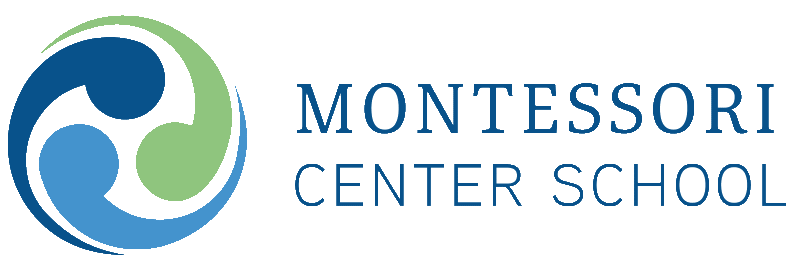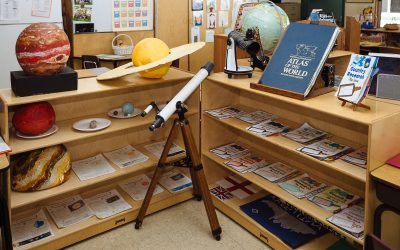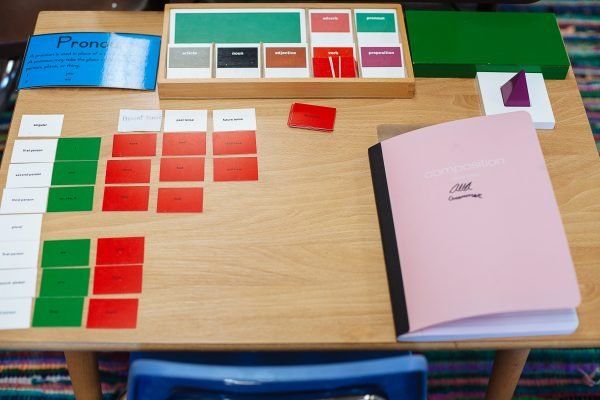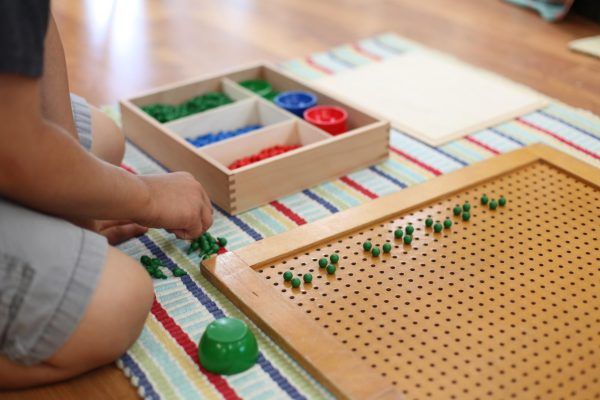Inside the Montessori Elementary Classroom

What sets Montessori apart in the Elementary years—ages 6 – 12—is the individually paced curriculum that challenges children academically and safeguards their well-being and sense of self. Engaging as contributing members of a respectful community, they learn to question, think critically, and take responsibility for their own learning—skills that will support them in later education and in life.
As at all Montessori levels, the Elementary program is based on the belief that children learn best through movement and work with their hands, and provides cognitive, social, and emotional support to help them reach their full potential.
This includes addressing their needs as they enter a new period of development characterized by:
- A transition from concrete to abstract thinking
- Growing interest in socialization
- Thinking and memory that is enhanced by creativity and imagination
- An interest in fairness, social justice, and compassion
The Elementary Classroom
In a Montessori Elementary classroom, students work individually or in small groups, at tables or on mats on the floor.
Natural lighting, soft colors, and uncluttered spaces set the stage for activity that is focused and calm. Learning materials are arranged on accessible shelves according to the curricular area, fostering independence as students go about their work. Everything is where it is supposed to be, conveying a sense of harmony and order that both comforts and inspires.
Children who are new to Montessori quickly feel at home with the inspired teaching that appeals to their deepest interests, and with the distinctive, hands-on learning materials that teachers introduce sequentially according to the students’ developmental needs. For students who have completed Montessori Early Childhood programs, the environment offers continuity with familiar routines and learning materials that offer new lessons and opportunities for more complex exploration and discovery.
The classroom is a happy community. Students are focused. They take joy in their work. They invent, explore, experiment, confer, create, prepare snacks, and curl up with books; sometimes they might even reflect in a peaceful, meditative corner. Meanwhile, teachers circulate, observing the students and making notes about their progress, ever ready to offer support or introduce new material, as appropriate.
Expectations are both exquisitely clear and engagingly open-ended.
The Montessori Elementary curriculum contains the following areas of learning:
Practical Life
Within the Elementary program, the Practical Life curriculum expands from the foundation laid in Early Childhood. Practical Life at the Elementary level shifts from a focus on self-care and fine motor skills, to skills that help children connect with their interests in the outside world, organize their time, and take part in their community.
While self-care and appropriate social interactions continue to be supported, lessons that teach responsibility are the focus. The use of tools, such as work plans, to support organization and time management skills, are incorporated into the daily routine.
Teachers and students often work together to post reminders about assignments, projects, and ideas. Using these, children make independent work choices, prioritize activities, and meet deadlines.
Math
The ideas of number concepts, place value, numerals, and related quantities are reinforced and expanded upon within the Elementary program. Newfound purposes for familiar math materials provide children with the means to consider number concepts, mathematical operations, and more complex functions, helping to expand advanced mathematical knowledge and understanding.
Language
Reading and writing are integral to all subjects in Montessori Elementary, as children express their interests and satisfy their curiosity. Students master conventions with thorough studies of grammar, spelling, and mechanics. They produce final copies with careful penmanship and keyboarding. They read, analyze, think critically, and compare and contrast literature to support personal opinion and perspective. Using these reading and writing skills, they present ideas through formal and informal presentations.
Cultural Studies
Cultural studies are interdisciplinary and integrate zoology, botany, geography, geology, physical and life sciences, and anthropology. Through these lessons, children explore the interconnectedness of all living things. Additionally, in-depth studies of history, physical and political world geography, civics, economics, peace and justice, the arts, world language, and physical education are introduced.
Science and Social Studies
Interdisciplinary and integrated studies of geology, geography, physical and life sciences, anthropology, and history are built around “Great Lessons,” a series of dramatic stories that explore the origins of the universe, our planet, and the continuous development of human advancement. The laws of physics and chemistry reveal the interdependency of all living things. Beginning with a study of civilization, students explore the contributions of history and what it means to be a responsible citizen and to seek ways to make the world a better, more peaceful place.
Montessori Learning Materials
Montessori students don’t just memorize facts and figures. They also learn the “hows,” “whens,” and “whys,” ensuring that learning takes place on a deep and fundamental level. Specially designed learning materials that use real objects and actions to translate abstract ideas into concrete form support them in this learning.
Teachers introduce materials to students according to their level of development and readiness. Students then work with the materials to make exciting discoveries—such as why, when dividing fractions, we invert and multiply. Inherent in the use of Montessori materials is the understanding of the power of discovering answers on one’s own.
Text Source: American Montessori Society
Programs
Montessori Center School admits students of any race, color, religion, national and ethnic origin, gender identity, and sexual orientation to all rights, privileges, programs and activities general recorded or made available to students at the School. It does not discriminate on the basis of race, color, religion, national and ethnic origin, gender identity or sexual orientation in the administration of its educational programs, admission and tuition assistance policies, and athletic or other school-administered programs. Non-Profit Education Organization, License No. 426205239





